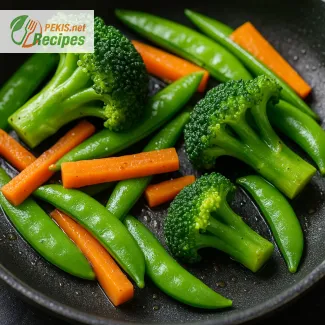
Keep vegetables crisp by mastering quick cooking methods like blanching, stir-frying, or roasting at high heat. The result is vibrant color, firm texture, and preserved nutrients for every dish. Balancing heat, time, and moisture makes the difference between soggy and perfectly crunchy.
PEKIS – professional chef and recipe developer with more than 25 years of experience, specialized in European and international cuisine. For this article, he shares proven culinary techniques on how to keep vegetables crisp and full of flavor during cooking.
Proven ways to keep vegetables fresh and crunchy while cooking
Simple culinary methods to preserve natural texture
Cooking vegetables can often result in soft or soggy textures, but with the right techniques it is possible to keep them fresh, vibrant, and crisp on the plate. The secret lies in understanding how heat, water, and time affect cell structure, and applying a few tried-and-true culinary strategies that chefs have relied on for centuries.
A brief historical perspective
Throughout history, different cultures developed unique approaches to preserve the crunch of vegetables. In East Asian cuisines, quick stir-frying in a hot wok keeps vegetables bright and crisp, while European kitchens traditionally used blanching followed by chilling to lock in freshness. These practices, though centuries old, remain the backbone of modern culinary techniques.
Key factors that influence texture
- Cooking time – The longer vegetables are exposed to heat, the more their structure breaks down.
- Water content – Vegetables with high natural water content (like zucchini or mushrooms) soften quickly.
- Temperature – High, quick heat helps sear the outside while keeping the inside firm.
- Cut size – Even cuts ensure uniform cooking, reducing the risk of some pieces becoming mushy.
Chef-approved methods for crisp vegetables
Blanching and shocking
A classic method where vegetables are briefly boiled and immediately placed into ice water. This stops cooking instantly, preserving color, nutrients, and crunch.
Stir-frying at high heat
Quickly cooking vegetables in a very hot pan or wok with a small amount of oil ensures a slightly charred surface while keeping the inside crisp.
Roasting with minimal oil
Placing vegetables on a baking sheet at high oven temperatures concentrates flavor and prevents sogginess. Spacing pieces apart is crucial to avoid steaming.
Steaming with precision
Gentle steaming retains texture and vitamins. The key is to steam only until just tender, not beyond.
Practical ideas for everyday cooking
- Combine blanched green beans with toasted almonds for a refreshing side.
- Use quick stir-frying for broccoli, bell peppers, and snow peas in Asian-inspired dishes.
- Roast root vegetables like carrots and parsnips to bring out sweetness without losing bite.
- Add crisp lettuce or lightly steamed spinach to grain bowls for contrast in texture.
Simple tricks that always work
- Salt water before blanching to enhance flavor and color.
- Dry vegetables thoroughly before roasting to avoid excess moisture.
- Cut vegetables evenly for consistent texture.
- Use chilled water after blanching to lock in crunch.
Combining tradition and modern cooking styles
Many of the best approaches draw from traditional methods while embracing modern techniques. A chef today might roast Brussels sprouts with olive oil for depth, then finish with a quick splash of lemon juice for brightness—an example of old and new blending perfectly.
Everyday inspiration in the kitchen
- Practical ideas: plan quick sides with minimal steps.
- Simple tricks: add texture contrasts in the same dish.
- Useful combinations: pair roasted vegetables with fresh raw toppings.
- Inspiration from traditional kitchens: try steaming with herbs for subtle aromas.
- Modern creativity: experiment with air-frying or convection roasting.
Why texture matters
Keeping vegetables crisp does more than improve mouthfeel—it preserves nutritional value, enhances visual appeal, and creates balance on the plate. Diners associate crunch with freshness, making it one of the most powerful sensory cues in cooking.
Keeping vegetables crisp
Mastering the art of maintaining crispness in vegetables is about respecting the ingredient. By using techniques like blanching, stir-frying, roasting, or steaming with care, you ensure that every dish feels lively and full of energy. Whether inspired by ancient traditions or modern chef’s tricks, the goal remains the same: vegetables that are delicious, colorful, and full of crunch.
FAQ questionWhat is the best way to keep vegetables crisp when cooking?
The most effective methods are quick cooking techniques such as blanching followed by an ice bath, stir-frying at high heat, or roasting in a hot oven. These preserve both texture and flavor.
FAQ questionWhy do vegetables become soggy during cooking?
Excess moisture and long cooking times cause cell walls to break down, releasing water and making vegetables soft instead of crunchy.
FAQ questionShould vegetables be cooked covered or uncovered to stay crisp?
Cooking uncovered usually helps excess steam escape, keeping vegetables from becoming soggy. Covering is best only when you want to trap moisture.
FAQ questionHow can I make roasted vegetables stay crunchy?
Dry them thoroughly before roasting, spread them in a single layer with space between pieces, and use a high oven temperature.
FAQ questionDoes blanching remove nutrients from vegetables?
A short blanch followed by shocking in cold water actually helps lock in nutrients, color, and crispness, as long as the process is not prolonged.
FAQ questionWhich vegetables are easiest to keep crunchy?
Firm vegetables like broccoli, carrots, snap peas, and bell peppers hold their texture well when cooked with quick high-heat methods.